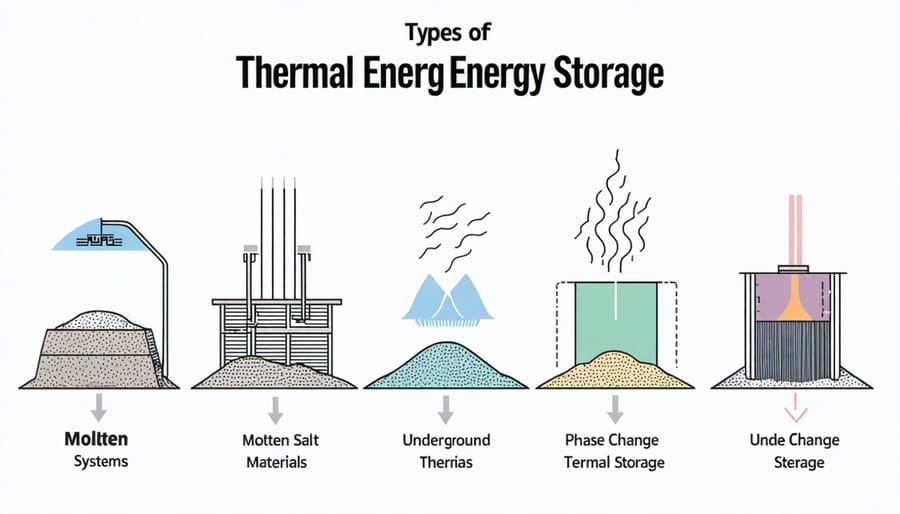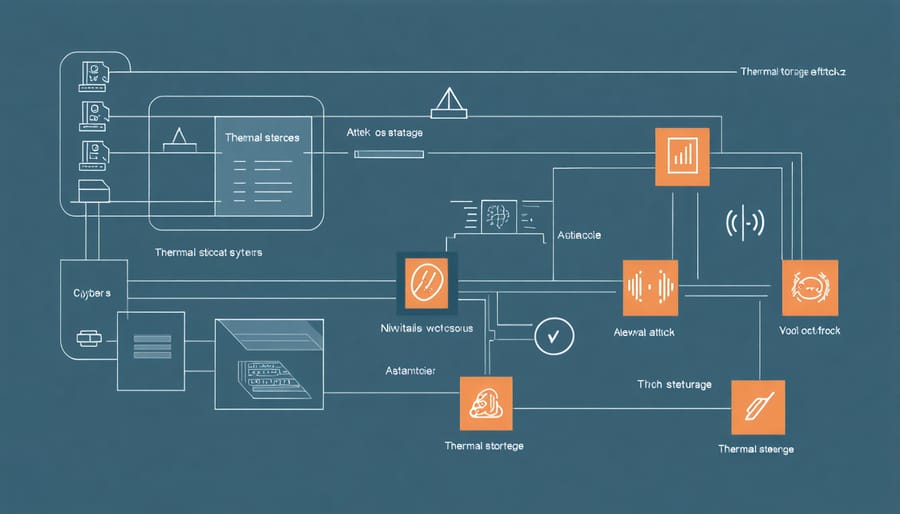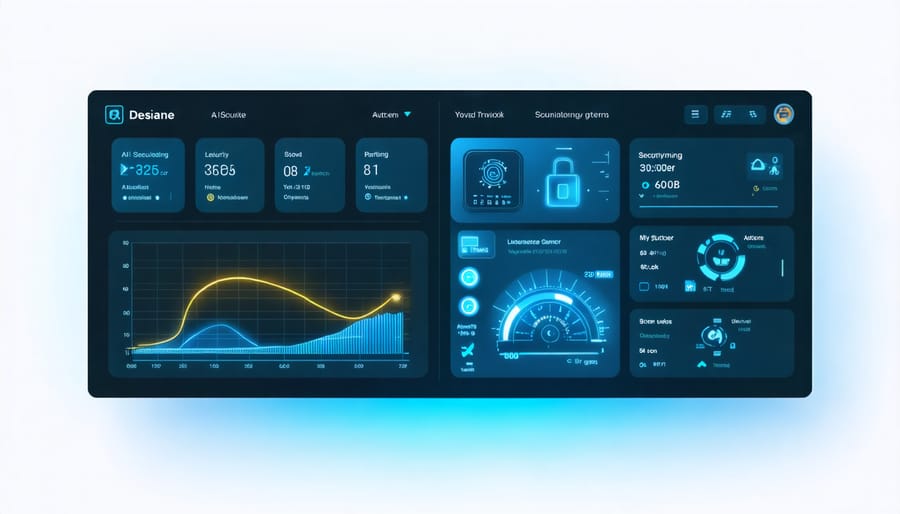Why Thermal Energy Storage Systems Are Now Prime Cyber Targets

Thermal energy storage systems represent one of the most promising solutions for addressing Europe’s growing energy challenges, offering a sophisticated bridge between intermittent renewable energy sources and consistent power demands. These innovative systems capture excess thermal energy during off-peak periods, storing it efficiently for later use when demand and costs peak. By transforming how industries and buildings manage their energy consumption, thermal storage technology has emerged as a cornerstone of sustainable energy infrastructure across the European Union.
In an era where energy security and climate action drive policy decisions, thermal storage systems deliver dual benefits: reducing operational costs for businesses while supporting the continent’s ambitious carbon reduction targets. From large-scale industrial applications to compact residential units, these systems provide flexible, reliable energy management solutions that enhance grid stability and optimize renewable energy integration.
The technology’s significance extends beyond immediate energy savings, enabling smarter grid operations and fostering energy independence for communities across Europe. As markets increasingly demand sustainable energy solutions, thermal storage systems offer a proven, scalable approach to meeting these evolving needs while ensuring continuous, reliable power supply for critical operations.
The Critical Role of Thermal Energy Storage in Modern Power Grids
Types of Thermal Storage Technologies
Modern thermal storage systems come in several distinct categories, each suited for specific applications and temperature ranges. Sensible heat storage, the most common type, uses materials like water, concrete, or thermal oils to store energy through temperature changes. This method is particularly popular in residential and commercial buildings due to its simplicity and cost-effectiveness.
Latent heat storage systems utilize phase change materials (PCMs) that absorb and release energy during state transitions. These systems offer higher storage density and are increasingly used in building climate control and industrial processes.
Underground thermal storage solutions represent another innovative approach, using geological formations or aquifers to store large quantities of thermal energy seasonally. This technology is particularly relevant for district heating systems and industrial applications across Europe.
Thermochemical storage, though still emerging, offers the highest energy density through reversible chemical reactions. This technology shows promise for long-term storage and industrial heat applications, particularly in regions with varying seasonal energy demands.

Integration with Solar and Wind Power
Thermal energy storage systems play a crucial role in maximizing the potential of renewable energy sources, particularly solar and wind power. These storage solutions address the intermittent nature of renewable generation by capturing excess energy during peak production periods for later use. When solar panels generate surplus electricity during sunny days, thermal storage systems can convert and store this energy as heat, making it available during cloudy periods or at night.
Similarly, during periods of high wind energy production, thermal storage systems can absorb and retain excess power, ensuring a steady energy supply when wind conditions are less favorable. This integration significantly improves the reliability and efficiency of renewable energy installations, making them more viable for both residential and industrial applications across Europe.
The combination of thermal storage with renewables also offers economic benefits, reducing dependency on grid power during peak pricing periods and optimizing self-consumption rates. Many European facilities have successfully implemented these hybrid systems, achieving energy cost reductions while contributing to sustainability goals and grid stability.
Cybersecurity Vulnerabilities in Thermal Storage Systems

Control System Vulnerabilities
Modern thermal energy storage systems rely heavily on digital control systems for optimal operation, making them potentially vulnerable to cybersecurity threats. These vulnerabilities primarily stem from interconnected sensors, automated management systems, and remote monitoring capabilities that, while essential for efficiency, can create potential entry points for unauthorized access.
Common security weaknesses include inadequately secured network connections, outdated software systems, and insufficient authentication protocols. Temperature sensors and flow controllers, which are crucial for maintaining proper thermal storage conditions, may be susceptible to manipulation if not properly protected. This could lead to system inefficiencies or, in extreme cases, safety risks.
To mitigate these risks, facility managers should implement robust security measures such as regular software updates, encrypted communications, and multi-factor authentication for system access. Particularly in industrial settings, where thermal storage systems are integrated with broader energy management platforms, maintaining secure firewalls and conducting regular security audits is essential.
European regulations increasingly emphasize cybersecurity in energy systems, requiring operators to implement comprehensive security protocols. This includes maintaining detailed access logs, establishing emergency response procedures, and ensuring all control system components meet current security standards. Regular staff training on security best practices and threat awareness is also crucial for maintaining system integrity.
Network Integration Risks
As thermal energy storage systems become increasingly integrated with smart grids, careful consideration of network security risks becomes essential. The digitalization of energy management systems brings both opportunities and vulnerabilities that require proactive measures to address.
Key security challenges include unauthorized access to control systems, data breach risks, and potential disruption of energy supply. Modern thermal storage installations often incorporate remote monitoring and control capabilities, making them potential entry points for cyber threats. This is particularly relevant for industrial facilities and district heating networks where multiple systems are interconnected.
European regulations, including the NIS Directive and GDPR, require robust cybersecurity measures for energy infrastructure. Organizations must implement multi-layer security protocols, including encrypted communications, secure authentication systems, and regular security audits. Regular software updates and patch management are crucial to maintain system integrity.
Best practices for risk mitigation include:
– Implementation of industrial firewalls
– Regular vulnerability assessments
– Employee cybersecurity training
– Incident response planning
– Secure remote access protocols
Facility managers should work closely with cybersecurity experts during system integration to ensure comprehensive protection. This collaboration helps create resilient systems that can safely deliver the benefits of thermal energy storage while maintaining data security and operational reliability.
For larger installations, consider implementing dedicated security monitoring systems and establishing clear protocols for system access and control modifications.
Security Best Practices for Thermal Storage Implementation
Access Control and Authentication
Modern thermal energy storage systems require robust access control and authentication measures to ensure operational security and data protection. These systems typically employ multi-factor authentication protocols, requiring users to verify their identity through combinations of passwords, security tokens, or biometric data before accessing control interfaces.
For industrial installations, role-based access control (RBAC) systems are implemented to restrict system functionality based on user responsibilities. Facility managers might have full administrative access, while maintenance personnel receive limited permissions for specific tasks. This granular approach to access management helps prevent unauthorized system modifications and protects critical operational parameters.
Security logs maintain detailed records of all access attempts and system changes, enabling audit trails and rapid response to potential security breaches. Regular security assessments and updates ensure that authentication protocols remain current with evolving cybersecurity standards.
European regulations, particularly the General Data Protection Regulation (GDPR), have shaped these security measures, ensuring that personal data associated with system access remains protected. This comprehensive security framework helps maintain system integrity while facilitating efficient operation and maintenance procedures.
Monitoring and Incident Response
Effective monitoring and incident response are crucial components of modern thermal energy storage systems. Implementing robust security monitoring systems helps ensure optimal performance while protecting against potential operational disruptions.
Real-time monitoring solutions track key parameters such as temperature levels, charging status, and system pressure. Advanced sensors and automated alerts notify operators of any deviations from preset thresholds, enabling swift response to potential issues. This proactive approach helps prevent system failures and maintains efficient energy storage operations.
A comprehensive incident response plan should include:
– Clear escalation procedures
– Emergency shutdown protocols
– Backup power systems
– Regular system health checks
– Documented recovery procedures
Regular staff training ensures quick and appropriate responses to various scenarios, from minor operational adjustments to major system alerts. Modern monitoring platforms often integrate with building management systems, providing centralized control and enhanced visibility across the entire thermal storage infrastructure.
To maintain system reliability, periodic audits and performance reviews help identify potential vulnerabilities and areas for improvement, ensuring your thermal energy storage system continues to operate at peak efficiency.
Regular Security Assessments
Regular security assessments are fundamental to maintaining the safety and reliability of thermal energy storage systems. These evaluations should be conducted quarterly, focusing on both physical infrastructure and digital control systems. For European facilities, compliance with EU energy security protocols and GDPR requirements adds an additional layer of necessary scrutiny.
A comprehensive security assessment typically includes monitoring of temperature sensors, pressure gauges, and control system access points. Special attention should be given to data logging systems and remote monitoring capabilities, ensuring they remain protected against potential cyber threats while maintaining operational efficiency.
Facility managers should establish a structured assessment schedule that includes:
– Physical inspection of storage units and containment systems
– Verification of safety valve functionality
– Review of access control systems and authorization protocols
– Testing of emergency shutdown procedures
– Evaluation of data backup and recovery systems
It’s recommended to engage certified security professionals who understand both thermal storage technology and industrial control systems. These experts can identify vulnerabilities that might be overlooked during routine maintenance checks and provide actionable recommendations for system improvements.
Documentation of all security assessments should be maintained and reviewed regularly, creating a historical record that helps identify patterns and potential areas of concern before they become critical issues.
Future-Proofing Thermal Storage Security
AI-Powered Security Solutions
Modern thermal energy storage systems increasingly rely on AI-powered energy management systems to ensure robust security protocols and protect against potential cyber threats. These intelligent solutions continuously monitor system operations, detect anomalies, and respond to security incidents in real-time.
Advanced machine learning algorithms analyze patterns in system behaviour, identifying potential vulnerabilities before they can be exploited. This predictive approach enables facility managers to implement preventive measures and maintain system integrity without disrupting daily operations.
Security features include automated access control systems, encrypted data transmission, and intelligent intrusion detection mechanisms. The AI components learn from each security event, adapting and strengthening defences against evolving threats while maintaining compliance with European data protection regulations.
For industrial applications, these security solutions integrate seamlessly with existing infrastructure monitoring systems, providing a comprehensive security framework that protects both physical assets and digital controls. The systems automatically document security events and generate detailed reports, helping facilities maintain audit trails and demonstrate regulatory compliance.
Regular security updates and patches are automatically evaluated and implemented, ensuring that protection measures remain current without requiring constant manual intervention. This automation reduces the risk of human error while maintaining optimal system performance and security levels.

European Security Standards and Compliance
European thermal energy storage systems must comply with stringent safety and security standards to ensure reliable operation and protect both infrastructure and end-users. The EN 14742 standard specifically addresses the safety requirements for thermal energy storage systems, covering aspects such as pressure vessel integrity, temperature control mechanisms, and emergency shutdown procedures.
Key regulations include the Energy Performance of Buildings Directive (EPBD), which mandates energy efficiency standards and safety protocols for integrated thermal storage systems in buildings. The Pressure Equipment Directive (PED) 2014/68/EU also plays a crucial role, establishing essential safety requirements for pressure equipment used in thermal storage installations.
For cybersecurity, the NIS2 Directive introduces mandatory risk assessment and incident reporting requirements for energy storage facilities. System operators must implement robust security measures to protect against cyber threats and unauthorized access to control systems.
Looking ahead, the European Union is developing additional standards focusing on the integration of thermal storage with smart grid systems. These upcoming regulations will emphasize interoperability, data protection, and resilience against both physical and cyber threats. Compliance with these standards will be mandatory for new installations from 2025 onwards.
Facility managers should regularly conduct security audits and maintain comprehensive documentation to demonstrate compliance with these evolving regulations. This proactive approach ensures both safety and legal conformity while maximizing the benefits of thermal energy storage technology.
As we’ve explored throughout this article, thermal energy storage systems represent a crucial component in Europe’s transition towards sustainable energy solutions. These systems not only enhance energy efficiency but also provide substantial cost savings for businesses and homeowners alike. However, the increasing integration of smart controls and monitoring systems necessitates a proactive approach to security.
The implementation of robust cybersecurity measures is not merely an option but a fundamental requirement for modern thermal storage installations. From basic access controls to advanced encryption protocols, each layer of security contributes to the overall resilience of these systems. Regular security audits, staff training, and continuous monitoring have emerged as essential practices for maintaining system integrity.
For European stakeholders, the path forward is clear: investing in secure thermal energy storage solutions while maintaining vigilant oversight of security protocols. The benefits of these systems – including reduced energy costs, improved grid stability, and decreased carbon emissions – can only be fully realized when protected by comprehensive security frameworks.
As thermal storage technology continues to evolve, staying informed about security best practices and emerging threats will become increasingly important. By embracing both innovative storage solutions and robust security measures, European organizations and homeowners can confidently participate in the clean energy transition while protecting their investments and infrastructure.
Leave a Reply